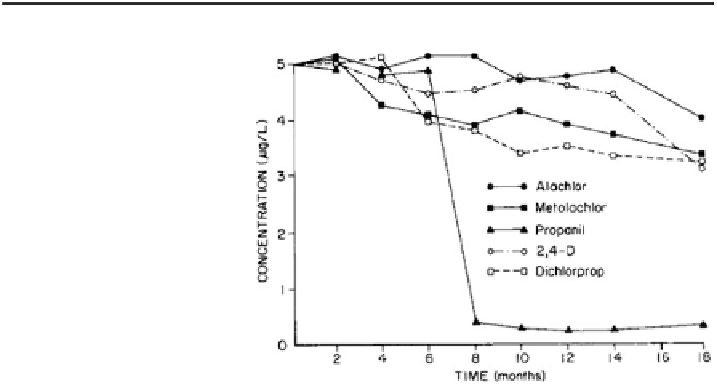Geoscience Reference
In-Depth Information
Table 17.4
(continued)
Compound
ng/L
Dimethylbutanol
70
Methylhexanol
30
Alkyl ester butanoic acid
150
Dibutyl phthalate
450
Alkyl ester propanoic acid
90
Benzeneacetaldehyde
10
Nitrogen-containing compounds
Methylquinoline
40
Quinolinol
20
C
4
hexanamide
80
C
2
methanamine
10
C
4
quinolinone
40
methyltriazole
30
Sulfur-containing compounds
Dimethyltrisulfide
10
C
5
tetrahydrothiophene
20
Fig. 17.18 Degradation of
herbicides incubated at 22 C
in groundwater from Dumas,
Arkansas (Cavaller et al.
1991
). Reprinted from
Cavaller et al. (
1991
).
Copyright (1991) with
permission of John Wiley and
Sons
time, it may be seen that in all the cases studied, traces of pesticide will remain in
the groundwater. As a consequence, we can consider that initial groundwater
chemistry is changed irreversibly on human lifetime scales.
Intensive data collection for the U.S. Geological Survey National Water-
Quality Assessment (NAWQA) was completed during 1993-1995 in 20 major
hydrologic basins of the United States. These studies indicated that pesticides were
commonly detected in shallow groundwater in 54.4 % of the 1,034 sampled sites
in agricultural (56.4 %) and urban (34.2 %) locations (Kolpin et al.
1998
). The
main pesticides detected were atrazine, deethylatrazine, simazine, metolachlor,
and prometon. The detection frequencies of pesticides having at least one con-
centration above 0.01 lg/L are presented in Fig.
17.19
.


